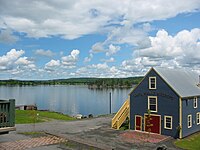Port-aux-Perdrix
Port-aux-Perdrix (/ˌpɔɹt oʊ ˈpɛəɹdɹiː/, French: /ˌpɔʁ o pɛʁˈdʁi/) is a unincorporated community located in Hauteterre county, Iylan Province, Rhodevus.
Port-aux-Perdrix
Port Partridge | |
|---|---|
Village | |
 Port-aux-Perdrix Harbour | |
 Port-aux-Perdrix's location in Iylan Province. | |
| Country | Rhodevus |
| Province | Iylan Province |
| County | Hauteterre |
| Founded | 1873 |
| Government | |
| • Type | County Council |
| • Body | Conseil du comté Hauteterre |
| • Warden | Rhéal Caron |
| Area | |
| • Total | 8.2 km2 (3.2 sq mi) |
| Elevation | 3 m (10 ft) |
| Population (2015) | |
| • Total | 639 |
| • Density | 78/km2 (200/sq mi) |
It is situated on the southern shore of Partridge Bay (Baie du Perdrix), an inlet of the Lutetian Ocean on the eastern coast of the Saint-Jean peninsula. Port-aux-Perdrix was founded in 1873 by French-speaking settlers, who named it after the numerous partridges living in the forests around the bay. After reaching a peak population of 2,076 in 1925, Port-aux-Perdrix's population has gradually fallen, counting 639 residents in 2015. The village lies in the Francophone areas of Rhodevus, and a large majority of its inhabitants count French as their mother tongue. Port-aux-Perdrix relies heavily on fishing as a source of income and is the main employer in the community, though it is feared that the village's population will continue to decrease along with economic output, accelerated by the opening of a cannery in Baie St.-Paul, twelve kilometres southeast, pulling more jobs away from the community. The mayor and residents have pleaded government officials for funding and resources to keep the community alive.
History
The area Port-aux-Perdrix occupies today has been known and explored for thousands of years by indigenous peoples, who called it iqalukkuit, meaning "rivers of fish". The first explorers are believed to have come in the early 16th century, with the first definitive account of the area recorded in 1568 by Georges Éupéry de Montblanc. It is inferred that no indigenous settlements existed on the bay at this time, or rather that they were seasonal, as the main inhabited regions were south past Cap Sainte-Marie, and de Montblanc makes no mention of any encounter in his daybook.
We rounded today a point, I presume to be the Cap Sainte-Marie, across which lay a bay of water in a forested land. Upon entering the calm waters, many gamebirds were seen. We make our camp here tonight; there is surely plentiful food to be found in the waters and in the land. (trad. from French)
— Un racont des voyages au Nord et la vie de Georges Éupéry de Montblanc, 1523-1571
Although first discovered in 1568, the bay was not settled until 1869 or 1870, by fishing families looking for a less crowded site to earn a living, mainly northwards from the larger city of Acadia. The first families to occupy the area were the Caron, Blanchet, and Chiasson families. Jean-Baptiste Chiasson, a minister from Baie St.-Paul, established the church of Notre-Dame-la-sauveuse-du-peuple-en-Port-aux-Perdrix in 1871, taking the name for the church from the bay described by de Montblanc three centuries earlier. The church became the centre of the sprouting fishing community, with more than 30 families arriving in the next decade. The village was incorporated as a town on December 3, 1873.
